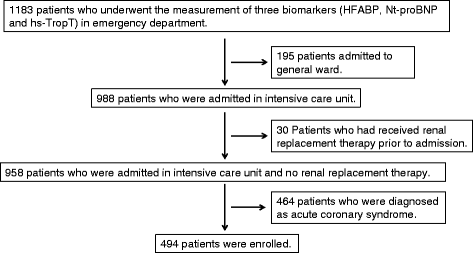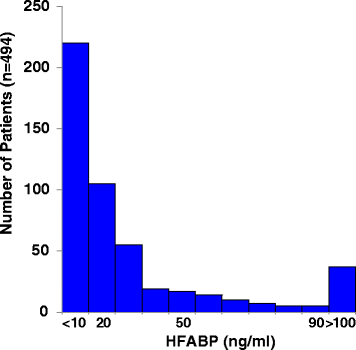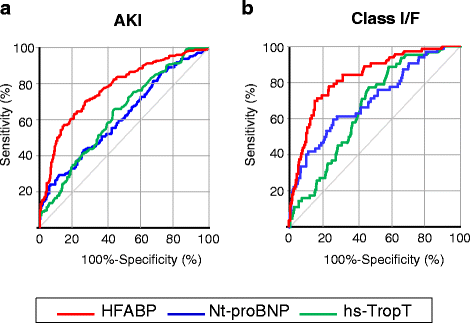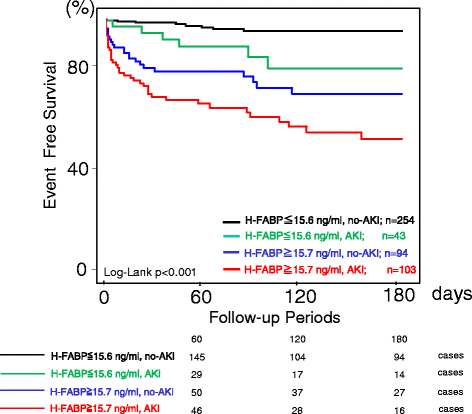The serum heart-type fatty acid-binding protein (HFABP) levels can be used to detect the presence of acute kidney injury on admission in patients admitted to the non-surgical intensive care unit
- PMID: 27596162
- PMCID: PMC5011936
- DOI: 10.1186/s12872-016-0340-1
The serum heart-type fatty acid-binding protein (HFABP) levels can be used to detect the presence of acute kidney injury on admission in patients admitted to the non-surgical intensive care unit
Abstract
Background: No cardiac biomarkers for detecting acute kidney injury (AKI) on admission in non-surgical intensive care patients have been reported. The aim of the present study is to elucidate the role of cardiac biomarkers for quickly identifying the presence of AKI on admission.
Methods: Data for 1183 patients who underwent the measurement of cardiac biomarkers, including the serum heart-type fatty acid-binding protein (s-HFABP) level, in the emergency department were screened, and 494 non-surgical intensive care patients were enrolled in this study. Based on the RIFLE classification, which was the ratio of the serum creatinine value recorded on admission to the baseline creatinine value, the patients were assigned to a no-AKI (n = 349) or AKI (Class R [n = 83], Class I [n = 36] and Class F [n = 26]) group on admission. We evaluated the diagnostic value of the s-H-FABP level for detecting AKI and Class I/F. The mid-term prognosis, as all-cause death within 180 days, was also evaluated.
Results: The s-H-FABP levels were significantly higher in the Class F (79.2 [29.9 to 200.3] ng/mL) than in the Class I (41.5 [16.7 to 71.6] ng/mL), the Class R (21.1 [10.2 to 47.9] ng/mL), and no-AKI patients (8.8 [5.4 to 17.7] ng/mL). The most predictive values for detecting AKI were Q2 (odds ratio [OR]: 3.743; 95 % confidence interval [CI]: 1.693-8.274), Q3 (OR: 9.427; 95 % CI: 4.124-21.548), and Q4 (OR: 28.000; 95 % CI: 11.245-69.720), while those for Class I/F were Q3 (OR: 5.155; 95 % CI: 1.030-25.790) and Q4 (OR: 22.978; 95 % CI: 4.814-109.668). The s-HFABP level demonstrating an optimal balance between sensitivity and specificity (70.3 and 72.8 %, respectively; area under the curve: 0.774; 95 % CI: 0.728-0.819) was 15.7 ng/mL for AKI and 20.7 ng/mL for Class I/F (71.0 and 83.1 %, respectively; area under the curve: 0.818; 95 % CI: 0.763-0.873). The prognosis was significantly poorer in the high serum HFABP with AKI group than in the other groups.
Conclusions: The s-H-FABP level is an effective biomarker for detecting AKI in non-surgical intensive care patients.
Keywords: Biomarker; Cardiovascular disease; Emergency care; Mortality; Renal dysfunction.
Figures




Similar articles
-
Serum heart-type fatty acid-binding protein level can be used to detect acute kidney injury on admission and predict an adverse outcome in patients with acute heart failure.Circ J. 2015;79(1):119-28. doi: 10.1253/circj.CJ-14-0653. Epub 2014 Nov 8. Circ J. 2015. PMID: 25381804
-
Prognostic impact of the serum heart-type fatty acid-binding protein (H-FABP) levels in patients admitted to the non-surgical intensive care unit.Clin Res Cardiol. 2014 Oct;103(10):791-804. doi: 10.1007/s00392-014-0717-z. Epub 2014 May 10. Clin Res Cardiol. 2014. PMID: 24817549
-
Perioperative heart-type fatty acid binding protein is associated with acute kidney injury after cardiac surgery.Kidney Int. 2015 Sep;88(3):576-83. doi: 10.1038/ki.2015.104. Epub 2015 Apr 1. Kidney Int. 2015. PMID: 25830762 Free PMC article.
-
Incidence, timing and outcome of AKI in critically ill patients varies with the definition used and the addition of urine output criteria.BMC Nephrol. 2017 Feb 20;18(1):70. doi: 10.1186/s12882-017-0487-8. BMC Nephrol. 2017. PMID: 28219327 Free PMC article. Review.
-
Risk stratification in acute pulmonary embolism with heart-type fatty acid-binding protein: A meta-analysis.J Crit Care. 2015 Oct;30(5):1151.e1-7. doi: 10.1016/j.jcrc.2015.05.026. Epub 2015 Jun 3. J Crit Care. 2015. PMID: 26111917 Review.
Cited by
-
Autophagy Dynamics and Modulation in a Rat Model of Renal Ischemia-Reperfusion Injury.Int J Mol Sci. 2020 Sep 29;21(19):7185. doi: 10.3390/ijms21197185. Int J Mol Sci. 2020. PMID: 33003356 Free PMC article.
-
Renal Assessment in Acute Cardiorenal Syndrome.Biomolecules. 2023 Jan 27;13(2):239. doi: 10.3390/biom13020239. Biomolecules. 2023. PMID: 36830608 Free PMC article. Review.
-
Potential Role of Novel Cardiovascular Biomarkers in Pediatric Patients with Chronic Kidney Disease.Mini Rev Med Chem. 2024;24(5):491-506. doi: 10.2174/1389557523666230523114331. Mini Rev Med Chem. 2024. PMID: 37231748 Review.
-
Kidney Diseases: The Age of Molecular Markers.Adv Exp Med Biol. 2021;1306:13-27. doi: 10.1007/978-3-030-63908-2_2. Adv Exp Med Biol. 2021. PMID: 33959903
-
Biomarker Development in Cardiology: Reviewing the Past to Inform the Future.Cells. 2022 Feb 8;11(3):588. doi: 10.3390/cells11030588. Cells. 2022. PMID: 35159397 Free PMC article. Review.
References
-
- Bellomo R, Ronco C, Kellum JA, Mehta RL, Palevsky P, Acute Dialysis Quality Initiative workgroup Acute renal failure- definition, outcome measures, animal models, fluid therapy and information technology needs; the Second International Consensus Conference of the Acute Dialysis Quality Initiative (ADQI) Group. Crit Care. 2004;8:R204–12. doi: 10.1186/cc2872. - DOI - PMC - PubMed
MeSH terms
Substances
LinkOut - more resources
Full Text Sources
Other Literature Sources
Miscellaneous

